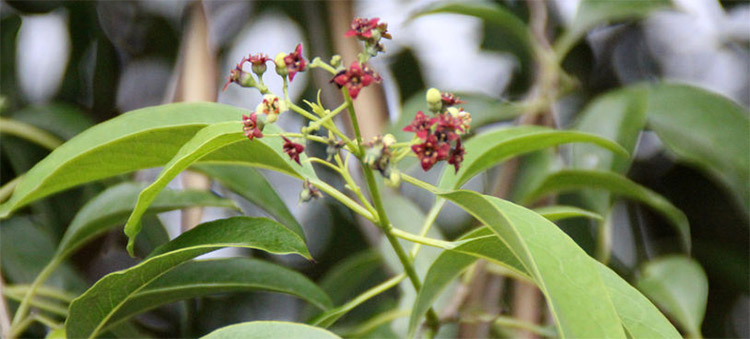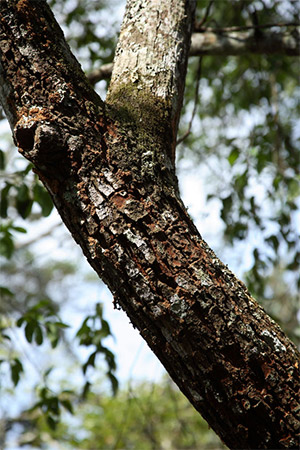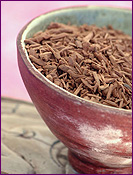Indian Sandalwood Essential Oil
Santalum album

Description
Indian Sandalwood Essential Oil is also known as East Indian Sandalwood Essential Oil and Sandalwood Mysore Essential Oil.
Indian Sandalwood Essential Oil is a profoundly versatile essential oil for its applications spiritual and emotional applications as well as its applications in perfumery/fragrancing and skin care.
Aromatically, Indian Sandalwood Essential Oil offers an exquisitely deep, woody aroma. It is frequently utilized in high end fragrances and is a favorite amongst both men and women. Indian Sandalwood is a base note that helps to beautifully round out blends.
Steffen Arctander describes the aroma as "having an extremely soft, sweet-woody and almost animal-balsamic odor, presenting little or no particular topnote, and remaining uniform for a considerable length of time due to its outstanding tenacity." (Source: Steffen Arctander, Perfume and Flavor Materials of Natural Origin (Reprint Edition. Elizabeth, NJ: Pathfinder., 2017), 575.)
Emotionally, Indian Sandalwood Essential Oil is calming and helps to instill a sense of inner peace. It is a good choice to try in cases of stress, depression or low self esteem. Indian Sandalwood is also considered an aphrodisiac.
The heartwood of Indian sandalwood has been used since ancient times as incense for spiritual applications. Indian Sandalwood Essential Oil is deeply grounding and is useful for chakra work.

Unlike with many essential oils where the aroma deteriorates over time, the aroma of East Indian Sandalwood essential oils is generally considered to improve with age.
Indian Sandalwood Essential Oil blends well with a wide array of essential oils and absolutes in the wood, floral, citrus and spice families including Neroli, Jasmine Absolute, Rose Otto and Absolute, Lavender, Sweet Orange, Petitgrain, Mandarin, Patchouli, Rosewood, Frankincense, Ylang Ylang, Tuberose Absolute, Cardamom, Coriander Seed and Copaiba Balsam.
Santalol, a sesquiterpenol, is the constituent that is primarily responsible for giving East Indian Sandalwood its distinctive and exquisite woody aroma. East Indian Sandalwood Essential Oil typically contains approximately 65-75% Santalol isomers.
In addition to its Santalol content, East Indian Sandalwood Essential Oil is abundant in other sesquiterpenols that contribute to its aromatic depth, therapeutic properties and more stable shelf life.
Other Species of Sandalwood Essential Oil
This profile pertains specifically to the Santalum album species of Sandalwood Oil that is commonly known as Indian Sandalwood Essential Oil. Several other species of sandalwood are distilled for their essential oil. Australian Sandalwood Essential Oil is also a lovely sandalwood oil.
Santalum paniculatum, commonly referred to as Hawaiian Sandalwood Essential Oil and Santalum austrocaledonicum vieille, commonly known as New Caledonian Sandalwood Essential Oil are also commercially available.
From my subjective experience, New Caledonian and Australian Sandalwood Essential Oils are the lightest in aroma with Hawaiian Sandalwood Essential Oil being slightly more fragrant and with most East Indian Sandalwood Essential Oils that I've smelled being the most fragrant.
Indian Sandalwood Essential Oil Benefits and Uses
- Anti-inflammatory
- Anxiety/Agitation
- Depression
- Varicose Veins
- Swollen Lymph Nodes
- Headache
- Insomnia
- Bronchitis
- Dry Cough
- Dry Skin
- Oily Skin
- Acne
- Eczema
- Psoriasis
- Stretch Marks
- Scalp Irritations
- Genitourinary Tract Infections
- Meditation
- Prayer
- Chakra Balancing
Sources: Salvatore Battaglia, The Complete Guide to Aromatherapy Third Edition Volume 1 - Foundations & Materia Medica (Brisbane Australia: Black Pepper Creative, 2018), 529-530. Julia Lawless, The Encyclopedia of Essential Oils (Updated Edition) (London: Harper Thorsons, 2014), 179-180.
Botanical Name

Plant Family
Common Method of Extraction
Steam Distillation
Plant Part Typically Used
Color

Clear with a Yellow Tinge
Consistency
Medium - Thick
Perfumery Note
Base
Strength of Initial Aroma
Medium
Aromatic Description
Indian Sandalwood Essential Oil smells rich, deep and sweet yet is delicate, woody and floral.
Indian Sandalwood Sustainability and Conservation Status
Vulnerable
Source: https://www.iucnredlist.org/species/31852/9665066
Exception: It is considered Critically Endangered in Timor Leste according to page 9 of the report Threatened, Endangered And Vulnerable Tree Species: A Comparison Between FRA 2005 And The IUCN Red List.
To learn more about the conservation status of essential oil bearing plants and how to use the IUCN Red List of Threatened Species, please refer to AromaWeb's Guide to Essential Oils and Sustainability.
Major Constituents of Indian Sandalwood Essential Oil
- (Z)-a-Santalol
- (Z)-B-Santalol
- (Z)-Nuciferol
- epi-B-Santalol
- (Z)-a-trans-Bergamotol
See Essential Oil Safety for more complete list of typical constituents.
Source: B.M. Lawrence, Essential Oils 1988-1991 (Wheaton: Allured Publishing, 1993), 180-182. Source cited in Robert Tisserand and Rodney Young, Essential Oil Safety (Second Edition. United Kingdom: Churchill Livingstone Elsevier, 2014), 418.
Indian Sandalwood Essential Oil Safety Information
Tisserand and Young indicate that although rare, Sandalwood Oil has the potential to cause adverse skin reactions. They recommend a dermal maximum of 2%. Reading Tisserand and Young's full profile is recommended. [Robert Tisserand and Rodney Young, Essential Oil Safety (Second Edition. United Kingdom: Churchill Livingstone Elsevier, 2014), 418-419.]
Sandalwood CO2 Supercritical Select Extract (Santalum album and Santalum spicatum
In addition to being available as an essential oil, this botanical is available from a small number of reputable sources as a CO2 extract. CO2 extracts offer many advantages. However, they can have differing safety precautions than essential oils because the natural chemistry of CO2 extracts can differ from their essential oil counterparts. Not much safety information is documented from trusted sources for CO2 extracts. Use CO2 extracts with great care and do not assume that every CO2 extract has the same safety precautions as its essential oil counterpart.
Indian Sandalwood Essential Oil References
- Robert Tisserand and Rodney Young, Essential Oil Safety (Second Edition. United Kingdom: Churchill Livingstone Elsevier, 2014), 418.)
- Salvatore Battaglia, The Complete Guide to Aromatherapy Third Edition Volume 1 - Foundations & Materia Medica (Brisbane Australia: Black Pepper Creative, 2018), 521-534.
- Salvatore Battaglia, The Complete Guide to Aromatherapy Third Edition Volume 3 - Psyche & Subtle (Brisbane Australia: Black Pepper Creative, 2021), 399-400.
- Steffen Arctander, Perfume and Flavor Materials of Natural Origin (Reprint Edition. Elizabeth, NJ: Pathfinder., 2017), 575.
General Safety Information
Do not take any oils internally and do not apply undiluted essential oils, absolutes, CO2s or other concentrated essences onto the skin without advanced essential oil knowledge or consultation from a qualified aromatherapy practitioner. For general dilution information, read AromaWeb's Guide to Diluting Essential Oils. If you are pregnant, epileptic, have liver damage, have cancer, or have any other medical problem, use oils only under the proper guidance of a qualified aromatherapy practitioner. Use extreme caution when using oils with children and be sure to first read the recommended dilution ratios for children. Consult a qualified aromatherapy practitioner before using oils with children, the elderly, if you have medical issues or are taking medications. Before using this or any essential oil, carefully read AromaWeb's Essential Oil Safety Information page. For in-depth information on oil safety issues, read Essential Oil Safety by Robert Tisserand and Rodney Young.
Shelf Life
Important Information About the Profiles
The essential oil information provided on AromaWeb is intended for basic educational purposes only. The references to safety information, test results, constituents and percentages is generalized information. Essential oils can vary greatly in composition. The data is not necessary complete and is not guaranteed to be accurate. The essential oil photos are intended to represent the typical and approximate color of each essential oil. However, essential oil composition and color can vary based on harvesting, distillation, age of the essential oil and other factors. Profiles for several CO2 Extracts and absolutes are included within the directory, and are denoted as such.
